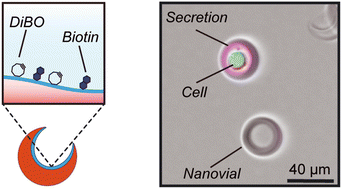Multi-reactive Hydrogel Nanovials for Temporal Control of Secretion Capture from Antibody-Secreting Cells
Michael Mellody, Yuta Nakagawa, Richard James and Dino Di Carlo
Lab on a Chip, January 2025
https://pubs.rsc.org/en/content/articlelanding/2025/lc/d4lc01056f
Abstract
Antibody discovery can benefit from techniques to screen antibody-secreting cells (ASCs) at scale for the binding and functionality of a diverse set of secreted antibodies. Previously, we demonstrated the use of cavity-containing hydrogel microparticles (nanovials) coated with a single affinity agent, biotin, to capture and identify ASCs secreting antibodies against a recombinant antigen bound to the nanovial through biotin–streptavidin linkages. However, rapidly secreted antibodies from unbound cells or cells in adjacent nanovials can cause crosstalk leading to background signal. Earlier efforts address this by localizing capture sites to the nanovial cavity, emulsifying nanovials, or short secretion times to limit secreted antibodies from binding to neighboring nanovials. Here, we demonstrate a method to functionalize nanovials with moieties that impart orthogonal reactivity, enabling conjugation of cell capture antibodies and antigens at different times. We show that by using a strained alkyne moiety to attach cell-capture antibodies via click chemistry to nanovials, we can capture cells and subsequently quantify secretions via biotin–streptavidin linkages. By delaying the loading of antigens onto the nanovials until after cell capture, we were able to ensure high purity (>95%) isolation of hybridoma secreting an antigen-specific antibody in a background of other hybridoma. This approach allows tight temporal control of the secretion measurement, which is independent of the cell loading time and requires less convective transfer steps. Click chemistry-based coupling further improved cell loading into nanovials by 58% compared to biotin–streptavidin–biotin coupling and caused no reduction in cell viability. We demonstrate an implementation of this system to improve antigen-specific hybridoma screening, yielding an 8-fold improvement in hybridoma enrichment while maintaining similar workflow complexity. Hybridomas on nanovials sorted into well plates regrew into colonies following sorting using standard fluorescence-activated cell sorting and maintained secretion of antigen-specific antibodies with high purity (∼90%), as validated via standard enzyme-linked immunosorbent assays. This lab-on-a-particle approach can be applied more generally to decouple cell loading, treatment, or activation, from secretion measurements for single-cell functional assays.
Topics
Technology

